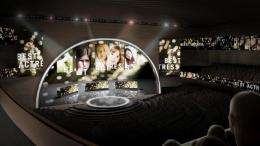January 19, 2010 weblog
Prysm's Ecovative Laser Phosphor Displays (LPDs): Consumer Tech Will Have To Wait

(PhysOrg.com) -- Ecovative. It's a word that may not have made it to your Webster's yet, but it has made it to 21st century design and technology. Ecovative is a movement, actually, that employs naturally available materials to create sustainable, replaceable, eco-friendly, cost-effective tools for the future.
Prysm, a 2005 start-up company in San Jose, California, recently released some tantalizing information about an ecovative technology it has on its plate: a laser phosphor display (LPD), to be unveiled next month at the Integrated Systems Europe trade show in Amsterdam. Prysm’s LPD meets three of the requirements to be considered ecovative right now. The fourth, cost-effectiveness, will come over time. LPD will initially cost more than its rivals to install, but will use 75 percent less energy to create its display.
This is essentially how the cost savings are achieved: Instead of transferring images using liquid crystals (LCD) or electronic semiconductors (LED), the LPD uses layers of phosphor in a solid structure such as glass. The phosphors emit red, green, and blue colors rapidly when the laser, reflected by many mirrors, scans their surface. There is very little filtering required in the LPD process, which usually comprises the bulk of energy use. Additionally, the phosphor is inactive during the scanning process, so it can never break down and require replacement
There are many other advantages of LPD, as the inventors, Roger Hajjar and Amit Jain, principles at Prysm, tell it. One really attractive feature, making LPD perfect for large advertising spaces, is that the phosphor pixels can be any shape, from small squares to long ribbons. This means that the pixels can bend to any size or shape display; an example being the theatre screen in the concept above. In fact, LPD can go from a small image to a huge one and back again with no distortion. Imagine that, Photoshoppers!
LPD can change images faster than LCD and LED technologies as well, making it an invaluable option for many real-time settings, such as space and weather stations, trading exchanges, broadcasting, airports, and security settings.
Maybe down the line, LPD will be the hottest thing to hit TV, computers, and smart phones... but don’t throw away your LCD and LED screens just yet. Prysm is marketing its LPD technology to the big screen, as in very big screen, first. Advertising displays in large cities, airports, cinemas, stadiums, command centers, financial center, and shopping malls will be among the first customers for LPD.
Just think how much money Las Vegas could save!
More information: -- How Laser Phosphor Display (LPD) Works: www.prysm.com/about_lpd.html
© 2010 PhysOrg.com



















